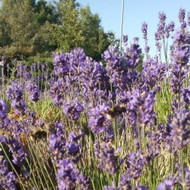5 Top Summer Gardening Tips
Posted by Morag, Celtic Sustainables on 12th Aug 2022

It's a hot and dry Summer this year for sure. We have compiled our top 5 tips for gardening in hot weather;
- Don’t cut your grass too short
Your lawn will get stressed in hot weather and it also gets stressed when it is cut short. You can’t do much about the weather (especially if we do get a hosepipe ban), but you can keep your grass a little longer than you might otherwise have.
Keeping your lawn at a longer length makes it a more resilient to dry weather – it encourages the plants to develop deeper root systems. The longer grass will also shade the soil more and keep the moisture in the Earth a bit more, all helping to keep your grass greener for longer. Other benefits to not cutting the grass as often or as short include: More time, more wildlife, more money!
- Re-use Water
If you have plants that are particularly susceptible to drying out during dry weather, you can use the water from your sink, shower and bath to water them - this is called "grey water".
As a couple of starters, we recommend putting a bucket in your shower to collect the water as it warms up to the temperature you prefer. You can also catch the water that you use when washing fruit and vegetables in your washing up bowl. This water is easy to re-use in garden.
Further steps would be to use the washing up water (if you use a washing up bowl that is - just check the ingredients in your washing up liquid will not harm the plants) or even to set up a grey-water system but that would be quite a big step (we don't recommend you store your grey water as it can quickly become a bacterial soup).
- Water your plants in the morning
The best time to water your plants in hot weather in very early in the morning. Certainly before the sun has had any chance to warm the day. This allows the water to soak into the cool soil and not evaporate back in the air. If you have to water during the day, go for as late as you can in the evening or when it is cloudy. Of course if a plant is looking particularly parched and on the edge of heat stroke then do water it, but drench it rather than give it just a little water. If it is a potted plant, soak it in a bucket of water (or pond) until the air bubbles stop rising to the surface of the water.
- Mulch your plants
As much as 70% of water can evaporate from the soil surface during a hot day. The best way to stop that is to add a protective layer of organic matter on top – known as a mulch. Mulching is one of the best strategies you can employ for keeping moisture in the soil, adding nutrients and suppressing weeds. Coarse bark is the type of mulch we prefer to use.
A few key things to know about mulching; only put the mulch on when the soil is already damp (so after a good rain event), make sure you have removed all the weeds before you put it on and spread it to a thickness of 5 to 8cm.
- Collect Rainwater
If you have a water butt or other rainwater harvesting tank you can connect a hosepipe to it and use saved rainwater to water your garden with garden hose or watering can. Thousands of litres of rainwater fall on your roof every year which is enough to fill even a very large water butt many times over. Water butts come in all shapes and sizes and can be beautiful too.
Water butts collect the rain from your roof via the downpipe. Simply fit a Diverter to your downpipe and the rain will flow into your water butt. The 3P Filter Collectors are a Diverter, Filter and Overflow all in one. A great piece of kit indeed.


